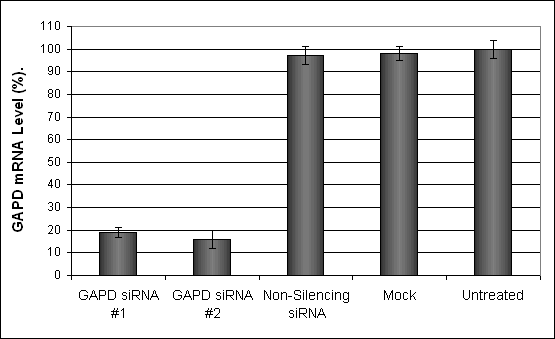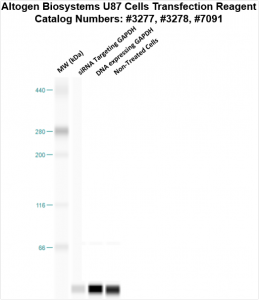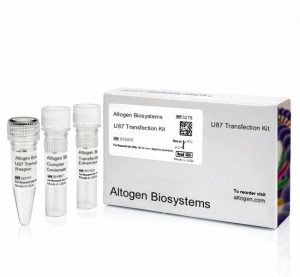Description
Purchase Orders: Click “Add to Cart” button to order, then email PO to orders@altogen.com.
Product Availability: In Stock.
Transfection Reagent for U87 Cells (Glioblastoma Cells)
-
Two component formulation enhances lipid mediated transfection efficiency
-
Optimized easy-to-use transfection protocol provided for transfection of siRNA, DNA, mRNA, and microRNA
-
Kit includes Transfection Enhancer reagent and recommended transfection protocol
-
High transfection efficacy in the presence of serum
-
Expand your RNAi application with a reagent optimized for delivery of both siRNA and plasmid
-
Download in vitro U87 transfection protocol: [PDF]
- Download U87 CRISPR/Cas9 transfection protocol: [PDF]
-
Download PowerPoint presentation for U87 cells transfection kit: [PPT]
-
Developed and manufactured by Altogen Biosystems
Transfection Efficiency:
Reagent exhibits at least 81% transfection efficiency of siRNA delivery. Transfection efficiency was determined by RT-PCR.
Product Description:
Enhanced transfection kit designed for superior efficiency in the U87 cell line, a human glioblastoma cells.
Transfection Protocol and SDS:
Download Altogen Biosystems U87 Transfection Protocol: [PDF]
Download SDS: [PDF]
U87 Cell Line:
U87 is a human glioblastoma cell line that was established from a malignant brain tumor. Glioblastoma is the most common and aggressive type of brain cancer, and it arises from the glial cells in the brain. Glioblastoma is a highly malignant tumor that originates from astrocytes and can be extremely difficult to eradicate due to it comprising many different cell types. Some of these cells react to treatment well, and others can be utterly unresponsive to drugs, as stated by the American Brain Tumor Association (ABTA). Human cell line models may lead to breakthroughs in brain cancer research and innovative treatment approaches that are essential for glioblastoma patients. U-87 MG is a human glioblastoma cell line derived from a stage three 44-year-old Caucasian female. It has epithelial morphology. Grade IV glioma, also called glioblastoma multiforme (GBM), is the most common primary malignant brain tumor with about 16,000 new diagnoses each year in the United States. GBMs have a one-year survival rate of only 29.6% making it one of the deadliest types of cancer. U-87 is a hypodiploid human cell line with the modal chromosome number of 44 that occurs in 48% of cells. The rate of higher ploidy is nearly 5.9%. Twelve markers are similar in all cells. There is only one copy of normal X, with N1, N6 and N9 being absent. U-87 MG cells are used as in vitro models of human glioblastoma cells to investigate the cytotoxic effect of chemotherapeutic drugs towards cancer cells. The U-87 glioblastoma cell line is widely used in transfection studies to examine the toxicology of potential treatment drugs. Altogen Biosystems provides optimized lipid-based transfection kits for this cell line.
U87 cell line mutations:
| PTPN5 | 84867 | 37 | 11 | 18754846 | 18754846 | Missense_Mutation | SNP | C | T |
| PTEN | 5728 | 37 | 10 | 89685315 | 89685315 | Splice_Site | SNP | G | T |
| DNAH9 | 1770 | 37 | 17 | 11556228 | 11556228 | Missense_Mutation | SNP | C | A |
| KIF1B | 23095 | 37 | 1 | 10396751 | 10396751 | Missense_Mutation | SNP | G | A |
| KLHDC7A | 127707 | 37 | 1 | 18808805 | 18808805 | Silent | SNP | A | C |
| HMGCL | 3155 | 37 | 1 | 24137247 | 24137247 | Silent | SNP | G | A |
| IPP | 3652 | 37 | 1 | 46184918 | 46184918 | Silent | SNP | G | A |
| C8A | 731 | 37 | 1 | 57378146 | 57378146 | Missense_Mutation | SNP | G | A |
| HOOK1 | 51361 | 37 | 1 | 60324690 | 60324690 | Missense_Mutation | SNP | C | T |
| SLC44A3 | 126969 | 37 | 1 | 95323019 | 95323019 | Missense_Mutation | SNP | A | T |
Data:

Figure 1. GAPD mRNA levels were quantified using real-time PCR in the U87 cells transfected with siRNAs targeting GAPD or non-silencing siRNA. Forty-eight hours post-transfection, the cells were harvested and analyzed by real-time PCR for GAPD mRNA expression levels. Data were normalized against the 18S rRNA signal. Control samples were either mock-transfected or untreated. Values are normalized to untreated sample. Data are means ± SD (n=5).

Figure 2. Protein expression of GAPDH in U87 cells. DNA plasmid expressing GAPDH or siRNA targeting GAPDH were transfected into U87 cells following Altogen Biosystems transfection protocol. At 72 hours post-transfection the cells were analyzed by Western Blot for protein expression levels (normalized by total protein, 10 µg of total protein loaded per each well). Untreated cells used as a negative control.
Selected in vivo transfection product citations (ALTOGEN® IN VIVO Transfection Kits used in the following publications):
- Nature. 2008 454(7203):523-7. Innate immunity induced by composition-dependent RIG-I …Saito et al [PDF]
- Am J Pathology. 2010 177(4):1870-80. Role of ocular complement factor H in a murine model … Lyzogubov et al [PDF]
- Nature Biotechnology. 2011 29(4):341-5. Delivery of siRNA to the mouse brain by … Alvarez-Erviti et al [PDF]
- Cancer Research. 2011 71(15):5144-53. Inhibition of miR-193a expression by… Iliopoulos et al [PDF]
- RNA. 2010 16(11):2108-19. RNase L releases a small RNA from HCV RNA that refolds … Malathi et al [PDF]
- Diabetologia. 2012 55(7):2069-79. The p47phox- and NADPH oxidase organiser 1 … Youn et al [PDF]
- British Journal of Cancer. 2012 107(3):516-26. TIGAR induces p53-mediated cell-cycle … Madan et al [PDF]
- Hypertension. 2014 63(2):353-61. Tissue transglutaminase contributes to … Liu et al [PDF]
- Circulation Research. 2010 15;107(8). Kruppel-like factor-4 transcriptionally regulates … Cowan et al [PDF]
- Hypertension. 2012 59(1):158-66. Role of uncoupled endothelial nitric oxide synthase … Gao et al [PDF]
- Jounal of Biological Chemistry. 2012 287(4):2907. Chaperoning of mutant p53 protein … Gogna et al [PDF]
- PLoS Pathogens. 2012 8(8) Uridine composition of the poly-U/UC tract of HCV RNA … Schnell et al [PDF]
- J Proteome Res. 2012(11) Retinal proteome analysis in a mouse model of oxygen-induced … Kim et al [PDF]
- J Transl Med. 2010 15;8:133. Prevention of hyperglycemia-induced myocardial apoptosis … Zhang et al [PDF]
- Mol Cell Biol. 2013 33(7). SCO2 induces p53-mediated apoptosis by Thr845 phosphorylation … Madan et al [PDF]
- PLoS Pathog. 2014 10(10) Exosomes from hepatitis C infected patients transmit HCV … Bukong et al [PDF]
Altogen Biosystems is a life sciences company that offers cell type-specific and pre-optimized transfection products, elecroporation kits, and in vivo delivery reagents. Advanced formulation of reagents and optimized transfection protocols provide efficient intracellular delivery of protein, DNA, mRNA, shRNA and siRNA molecules. Read more about transfection technology at Altogen’s Transfection Resource. Altogen Labs provides safety and efficacy preclinical research services. GLP-compliant studies for IND applications, and drug development, including over 90 in-house validated xenograft models, safety toxicology, etc (visit AltogenLabs.com).
Volume Options:
- 0.5 ml (Catalog #3277)
- 1.5 ml (Catalog #3278)
- 1.5 ml CRISPR (Catalog #2200)
- 8.0 ml (Catalog #7091)
Purchase Orders: Click “Add to Cart” button to order, then email PO to orders@altogen.com.
Product Availability: In Stock.






